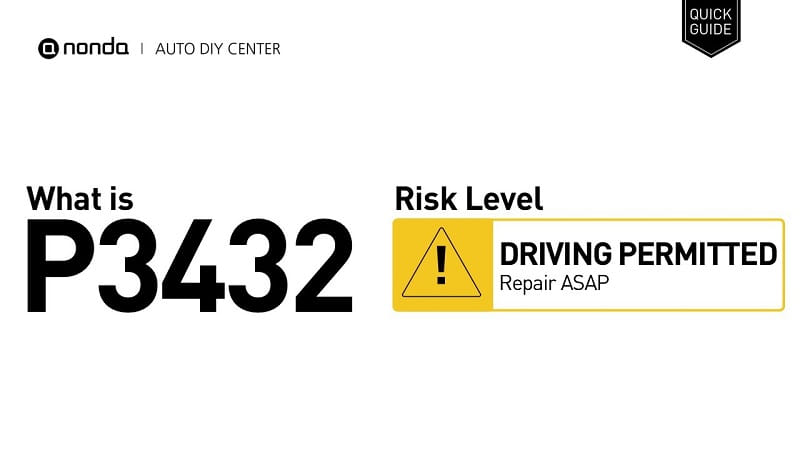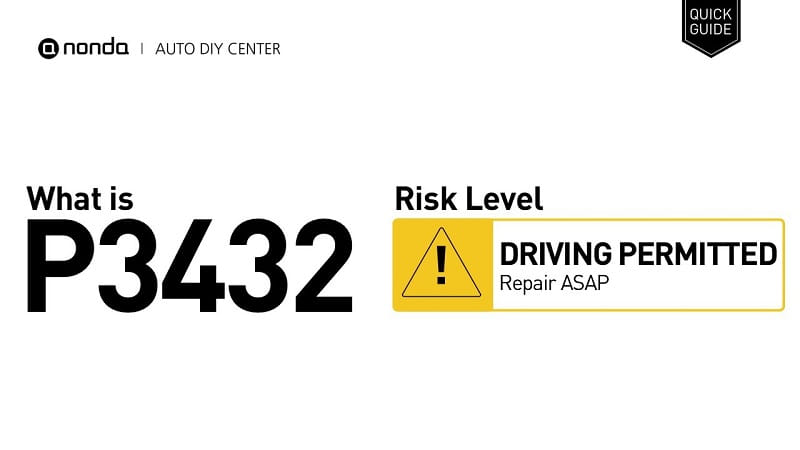This post contains affiliate links. This means I will make a commission at no extra cost to you should you click through and make a purchase [ “As an Amazon Associate, I earn from qualifying purchases.” ]. Read the full disclosure here.
Understanding Diagnostic Trouble Code P3432: Cylinder 4 Exhaust Valve Control Circuit High GuideMechanic.Com Modern internal combustion engines are becoming increasingly sophisticated with the integration of advanced valve control systems.
Among these, cylinder deactivation technology is widely used to improve fuel efficiency and reduce emissions by selectively shutting off fuel and valve operation in certain cylinders during light-load conditions.
The exhaust valve control circuit plays a crucial role in this system by regulating the exhaust valves’ operation electronically.
When an abnormal voltage condition occurs in the circuit controlling the exhaust valve of cylinder 4, the Engine Control Module (ECM) may trigger a Diagnostic Trouble Code (DTC) known as P3432, indicating a high voltage fault in this circuit.
This article provides an in-depth explanation of P3432, including its causes, symptoms, diagnostic steps, and repair options, offering useful information for vehicle owners and technicians alike.
See Also: P3433 Cylinder 5 Deactivation/Intake Valve Control Circuit/Open
P3432 Cylinder 4 Exhaust Valve Control Circuit High
What Does DTC P3432 Mean?

The P3432 trouble code refers to “Cylinder 4 Exhaust Valve Control Circuit High” voltage. This means that the ECM has detected a voltage level higher than the expected range in the electrical circuit controlling the exhaust valve actuator (or solenoid) of cylinder 4.
Unlike a low voltage code (such as P3431), a high voltage condition usually implies that there might be a short to a positive voltage supply or an open or faulty sensor that is causing the circuit to report excessive voltage back to the ECM. This condition can prevent the exhaust valve from functioning correctly, affecting valve timing and engine performance.
How the Exhaust Valve Control Circuit Works
To understand the implications of the P3432 code, it is important to know how the exhaust valve control system operates:
Exhaust Valve Control Solenoid: The ECM sends an electrical signal to the exhaust valve control solenoid, which regulates hydraulic oil flow to the exhaust valve lifters.
Valve Operation: By controlling oil pressure, the solenoid engages or disengages the exhaust valve mechanism, allowing for valve activation or deactivation based on engine load and operating conditions.
Electrical Circuit: The solenoid operates within a specific voltage range. Deviations from this range trigger the ECM to log fault codes like P3432 when voltages are excessively high.
P3432 Cylinder 4 Exhaust Valve Control Circuit High
Symptoms of P3432
When P3432 is active, you may notice several symptoms related to exhaust valve control malfunction:
- Check Engine Light (CEL) is illuminated
- Engine runs rough or exhibits misfires
- Reduced fuel efficiency and power
- Engine hesitation or stumbling during acceleration
- Loss of cylinder deactivation functionality, resulting in increased fuel consumption
- Unusual noises from the valve train or exhaust system
In some cases, the vehicle may enter a limp mode to protect the engine, reducing power until the problem is resolved.
Common Causes of P3432
Several factors can contribute to a high voltage condition in the Cylinder 4 Exhaust Valve Control Circuit:
1. Short to Voltage in Wiring or Connector
Damaged wiring or a pinched harness may cause the solenoid circuit to have a short to battery voltage, sending an abnormally high voltage signal to the ECM.
2. Faulty Exhaust Valve Control Solenoid
An internal electrical failure in the solenoid (such as a shorted coil winding) can result in excessive voltage or current flow.
3. Poor Connector or Terminal Contacts
Corrosion or loose connections at the solenoid connector can lead to incorrect voltage readings and intermittent high voltage conditions.
4. Damaged or Faulty ECM
A malfunctioning ECM may incorrectly interpret the voltage signals or supply improper voltage to the control circuit.
5. Aftermarket Electrical Modifications
Unauthorized or incorrect modifications to the wiring or electrical components can cause abnormal voltages.
P3432 Cylinder 4 Exhaust Valve Control Circuit High
Diagnosing P3432
Diagnosing P3432 requires a thorough and systematic approach:
Step 1: Retrieve and Confirm Code
Use an OBD-II scan tool to retrieve DTC P3432.
Check for other related codes that might help narrow down the problem.
Step 2: Visual Inspection
Inspect the wiring harness and connectors at the Cylinder 4 Exhaust Valve Control Solenoid.
Look for signs of damage such as broken wires, abrasions, burnt insulation, or corroded terminals.
Step 3: Check Voltage at the Solenoid Connector
With the ignition ON (engine off), measure the voltage at the solenoid connector using a multimeter.
Confirm that the voltage is within the expected range (usually 12V when activated, 0V when off).
A reading significantly higher than battery voltage or a constant high voltage signal may indicate a short or open circuit.
Step 4: Test the Solenoid
Remove the solenoid and test its coil resistance with a multimeter; compare with manufacturer specifications.
Connect the solenoid directly to a 12V power source momentarily to check for proper operation.
Step 5: Inspect and Test the Wiring Harness
Check continuity between the ECM and solenoid connector.
Look for any shorts to power or ground.
Step 6: Check ECM Output
Using an advanced scan tool, command the solenoid ON and OFF while monitoring voltage and current.
Abnormal readings suggest ECM output or internal solenoid faults.
P3432 Cylinder 4 Exhaust Valve Control Circuit High
Repair Procedures for P3432
Once the root cause is identified, proceed with appropriate repairs:
1. Repair or Replace Wiring and Connectors
Fix any damaged wiring, repair chafed insulation, or replace connectors showing corrosion or poor contact.
2. Replace the Exhaust Valve Control Solenoid
If the solenoid is internally faulty or damaged, replace it with a high-quality OEM or equivalent component.
3. ECM Repair or Replacement
If testing indicates the ECM output circuit is defective, consult the manufacturer or a qualified professional for ECM repair or replacement.
4. Clear the Code and Test Drive
After repairs, clear the DTC using an OBD-II scanner and perform a test drive to verify the issue is resolved.
P3432 Cylinder 4 Exhaust Valve Control Circuit High
Can You Drive with P3432?
Driving with P3432 is not recommended, as a malfunctioning exhaust valve control circuit can:
- Increase fuel consumption due to loss of cylinder deactivation.
- Cause engine misfires or rough running.
- Potentially cause damage to valve train components if the valve timing is incorrect.
- Increase emissions, possibly leading to failed emissions tests.
- Prompt repair maintains engine health and ensures optimal performance.
Preventive Tips
To prevent the occurrence of P3432, consider these maintenance and care tips:
- Use only manufacturer-recommended engine oil and change it regularly to maintain proper solenoid function.
- Inspect wiring harnesses during routine maintenance to catch damage early.
- Avoid aftermarket modifications that affect the valve control or engine electrical systems.
- Keep connectors clean and protected from moisture and corrosion.
- Follow manufacturer service intervals for valve and solenoid inspection or replacement.
Conclusion
Diagnostic Trouble Code P3432 signals a high voltage issue in the Cylinder 4 Exhaust Valve Control Circuit. This fault can disrupt exhaust valve operation, impair cylinder deactivation, and negatively impact engine performance, fuel efficiency, and emissions.
Understanding the symptoms, causes, and proper diagnostic procedures is essential to address the problem effectively.
Through careful inspection, testing, and repairs—whether replacing the solenoid, fixing wiring issues, or addressing ECM faults—you can restore the valve control circuit to proper function and keep your engine running smoothly.
If you encounter this code, timely action is key to preventing further engine issues and maintaining the longevity of your vehicle.
- Custom Lifted Diesel Trucks for Sale - December 20, 2025
- New Lifted Diesel Trucks for Sale - December 19, 2025
- Old Lifted Diesel Trucks for Sale - December 18, 2025

